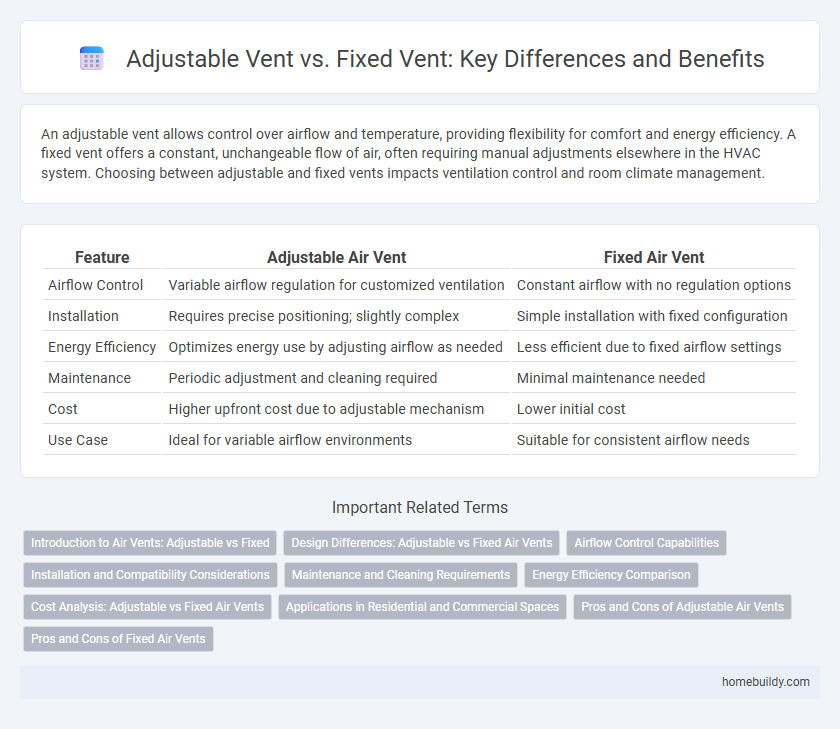An adjustable vent allows control over airflow and temperature, providing flexibility for comfort and energy efficiency. A fixed vent offers a constant, unchangeable flow of air, often requiring manual adjustments elsewhere in the HVAC system. Choosing between adjustable and fixed vents impacts ventilation control and room climate management.
Table of Comparison
| Feature | Adjustable Air Vent | Fixed Air Vent |
|---|---|---|
| Airflow Control | Variable airflow regulation for customized ventilation | Constant airflow with no regulation options |
| Installation | Requires precise positioning; slightly complex | Simple installation with fixed configuration |
| Energy Efficiency | Optimizes energy use by adjusting airflow as needed | Less efficient due to fixed airflow settings |
| Maintenance | Periodic adjustment and cleaning required | Minimal maintenance needed |
| Cost | Higher upfront cost due to adjustable mechanism | Lower initial cost |
| Use Case | Ideal for variable airflow environments | Suitable for consistent airflow needs |
Introduction to Air Vents: Adjustable vs Fixed
Adjustable air vents offer customizable airflow control, allowing users to regulate ventilation according to specific room requirements, enhancing both comfort and energy efficiency. Fixed air vents provide a constant, unchanging flow of air, ideal for spaces where consistent ventilation is necessary without the need for frequent adjustments. Choosing between adjustable and fixed vents depends on the desired control over airflow and the ventilation system's overall design.
Design Differences: Adjustable vs Fixed Air Vents
Adjustable air vents feature movable louvers or dampers that allow users to control airflow direction and volume, enhancing room comfort and energy efficiency. Fixed air vents, by contrast, have a static design with permanent openings that provide consistent airflow but lack customization options. The design differences impact ventilation performance, with adjustable vents offering flexibility in airflow management while fixed vents prioritize simplicity and durability.
Airflow Control Capabilities
Adjustable vents provide superior airflow control capabilities by allowing users to regulate the volume and direction of air entering a room, enhancing comfort and energy efficiency. Fixed vents, in contrast, offer limited airflow management since their openings remain constant, leading to less flexibility in air distribution. Optimal ventilation systems often incorporate adjustable vents to adapt to varying temperature and occupancy needs.
Installation and Compatibility Considerations
Adjustable air vents offer greater installation flexibility, allowing for precise control of airflow direction and volume, which is ideal for varied room layouts and HVAC systems. In contrast, fixed vents require exact placement to ensure effective air distribution, limiting compatibility with dynamic or frequently changing ventilation needs. Compatibility considerations include duct size, wall or ceiling mounting options, and integration with existing ventilation controls, where adjustable vents often provide broader adaptability than fixed models.
Maintenance and Cleaning Requirements
Adjustable air vents offer easier access for routine maintenance and cleaning, allowing homeowners to quickly remove dust and debris, which helps maintain optimal airflow. Fixed vents, however, often require more effort to clean thoroughly because they cannot be opened or adjusted, leading to potential buildup that restricts air circulation. Choosing an adjustable vent enhances ventilation system efficiency by simplifying regular upkeep and extending the lifespan of air duct components.
Energy Efficiency Comparison
Adjustable air vents provide superior energy efficiency by allowing users to control airflow, reducing unwanted heating or cooling loss and optimizing HVAC system performance. Fixed vents often result in constant airflow regardless of room occupancy, leading to energy waste and higher utility costs. Studies show that adjustable vents can decrease energy consumption by up to 15%, enhancing overall system efficiency and sustainability.
Cost Analysis: Adjustable vs Fixed Air Vents
Adjustable air vents typically cost more upfront than fixed vents due to their complex design and movable components, but they offer long-term savings by allowing precise airflow control and improved energy efficiency. Fixed vents have lower installation costs and simpler maintenance but can lead to higher energy bills since they cannot regulate airflow based on room requirements. Evaluating the balance between initial investment and ongoing energy savings is crucial for effective cost management in HVAC systems.
Applications in Residential and Commercial Spaces
Adjustable air vents provide precise airflow control, making them ideal for both residential areas where personalized comfort is important and commercial spaces requiring flexible ventilation solutions. Fixed vents offer a cost-effective option with consistent airflow, suitable for areas with stable air circulation needs such as utility rooms or warehouses. Selecting adjustable or fixed vents depends on the specific requirements of airflow regulation and energy efficiency in homes or commercial buildings.
Pros and Cons of Adjustable Air Vents
Adjustable air vents offer the advantage of customizable airflow, allowing users to control the direction and volume of air for enhanced comfort and energy efficiency. However, their moving parts can be prone to wear and may require more maintenance compared to fixed vents, which provide consistent airflow without adjustments. While adjustable vents optimize ventilation flexibility, fixed vents often deliver greater durability and lower long-term upkeep costs.
Pros and Cons of Fixed Air Vents
Fixed air vents provide consistent airflow and require minimal maintenance due to the absence of moving parts, making them durable and reliable for long-term use. However, their inability to regulate or adjust air volume can lead to inefficient temperature control and increased energy costs in spaces requiring variable ventilation. Fixed vents are ideal for areas where constant airflow is essential, but they lack the versatility of adjustable vents in tailoring ventilation to specific comfort needs.
adjustable vent vs fixed vent Infographic

 homebuildy.com
homebuildy.com